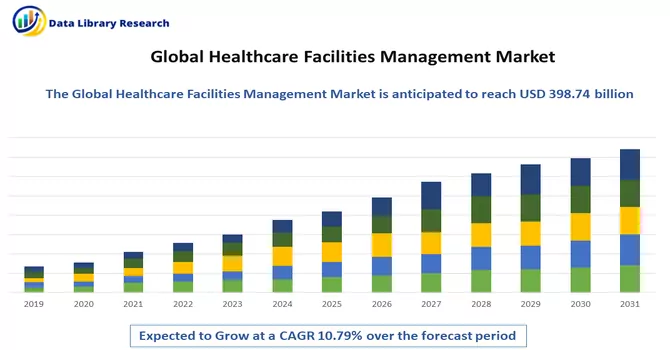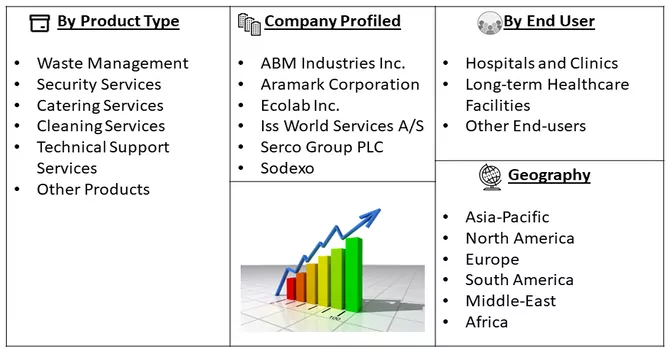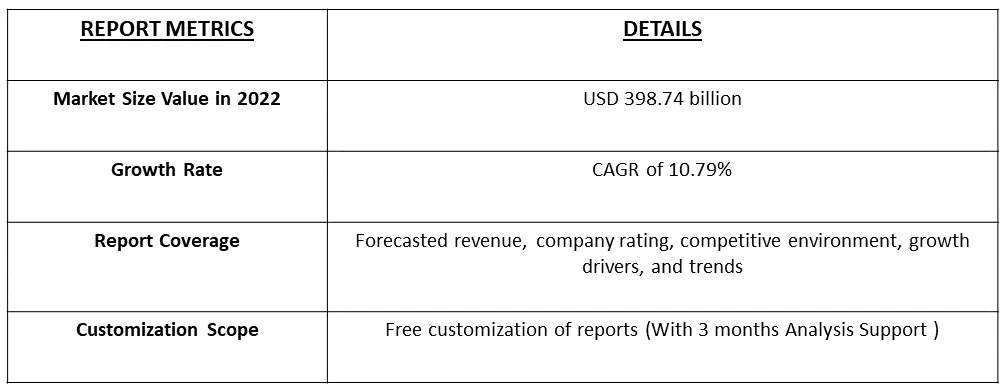The Healthcare Facilities Management Market size is currently valued at USD 398.74 billion in 2022 and is expected to register a CAGR of 10.79% during the forecast period (2023-2030).

Get Complete Analysis Of The Report - Download Free Sample PDF
The healthcare facilities management market is predicted to witness rapid growth due to rising global healthcare expenditures, along with an increase in chronic diseases and medical tourism in emerging countries.
Healthcare facilities management plays a crucial role in maintaining a safe and well-functioning environment for healthcare delivery. It requires expertise in both facility management principles and healthcare-specific regulations and standards to ensure that healthcare facilities can provide quality patient care while operating effectively and efficiently.
Segmentation:
The Global Healthcare Facilities Management Market is segmented By Product Type (Waste Management, Security Services, Catering Services, Cleaning Services, Technical Support Services, and Other Products), By End-user (Hospitals and Clinics, Long-term Healthcare Facilities, and Other End-users), and Geography (North America, Europe, Asia-Pacific, Middle East, and Africa, and South America). The report offers the value (in USD billion) for the above segments.

For Detailed Market Segmentation - Download Free Sample PDF
Healthcare facilities were increasingly adopting technology solutions for better management. This included Computerized Maintenance Management Systems (CMMS), Internet of Things (IoT) devices for equipment monitoring, and the use of data analytics to optimize operations. Also, hospitals and healthcare facilities were focusing on sustainability and energy efficiency to reduce operational costs and minimize their environmental footprint. This included investments in green building design, renewable energy sources, and waste reduction programs.
Drivers:
Growth in Healthcare Expenditures and Increase in Occurrence of Chronic Diseases
The healthcare sector is now a major player, driven by a rising number of patients and increased healthcare spending from both public and private sources. A report from the OECD Health Statistics in July 2021 indicated that in a group of 16 countries, per capita health spending increased by an average of about 4.9%. Additionally, data from the Centers for Medicare and Medicaid Services (CMS) in the United States projected that national healthcare spending would grow by an average of 5.5% per year from 2018 to 2027, reaching nearly USD 6.0 trillion by 2027. Over this period, healthcare spending is expected to increase by 0.8% more than the GDP each year, resulting in healthcare accounting for 19.4% of the GDP by 2027. This surge in healthcare spending has led to the development of various healthcare facilities in hospitals and clinics, all aimed at improving patient well-being. This growth is expected to have a significant impact on the market.
Moreover, the increase in chronic diseases is expected to contribute to the market's growth. For instance, per the data published by the European Cancer Information System in 2020, the estimated incidence of non-melanoma skin cancer is expected to reach 3,244,076 by 2040. The burden of cancer cases is expected to be the admission of many people in hospitals for long-term care, thus boosting the demand for catering, porterage, cleaning, and other associated services, thereby contributing to the market's growth.
Increasing Medical Tourism in Emerging Countries
The increasing trend of medical tourism in emerging countries presents both opportunities and challenges for healthcare facility management. Facility managers need to adapt to meet the unique demands of international patients while maintaining the highest standards of care, safety, and efficiency. Popular destinations for medical tourism include countries like Thailand, India, Mexico, Malaysia, South Korea, and Turkey. These countries offer a wide range of medical procedures at a fraction of the cost in developed countries. For instance, the United Nations 2022 report stated that a coronary angioplasty procedure costs around USD 55,000 to USD 57,000 for an individual in the U.S., compared to approximately USD 4,500 to USD 10,000 in Malaysia. People travel from the U.S. and Europe for treatments to Singapore, Malaysia, India, and Thailand, saving between 55% and 70% on medical costs. Thus, medical tourists seek low-cost medical procedures and cost savings are a significant driver for medical tourism, as the patients can save 30% to 70% or more on medical procedures when choosing to have them done in a medical tourism destination. Thus, such instances are driving the growth of the studied market over the forecast period.
Restraints:
Lack of Investment in Facilities Management in Low-income Countries
The lack of investment in facilities management in low-income countries should involve a combination of local and international initiatives. This may include financial support, capacity building, training, and collaboration with healthcare professionals and facility managers to prioritize infrastructure improvements. Low-income countries often struggle with insufficient healthcare infrastructure, including hospitals and clinics. Many of these facilities lack proper maintenance, modern equipment, and adequate space for patient care. Thus, such factors may slow down the growth of the studied market over the forecast period.
The global healthcare facilities management market experienced significant growth during the COVID-19 pandemic. The surge in COVID-19 cases led to an increase in diagnostic and treatment procedures, generating a substantial volume of medical waste. According to the World Health Organization (WHO) data from February 2022, the management of the additional medical waste generated during the pandemic strained healthcare waste management systems worldwide. Furthermore, even in the post-pandemic period, there is a growing need for sustainable healthcare facilities management systems. This sustained demand is expected to drive the growth of the healthcare facilities management market in the next five years.
Segmental Analysis:
The Security Services Segment is Expected to Witness Significant Growth Over the Forecast Period
Security services are an integral part of healthcare facility management, contributing to patient safety, asset protection, regulatory compliance, and the overall well-being of the facility. Collaboration between facility management and security services is essential to create a secure and efficient healthcare environment. Security services are responsible for implementing access control measures in healthcare facilities. This involves managing entry points, visitor access, and the use of security badges or access cards. Access control helps prevent unauthorized individuals from entering sensitive areas and ensures the safety and privacy of patients. Thus, the segment is expected to witness significant growth over the forecast period.
Hospitals and Clinics Segment is Expected to Witness Significant Growth Over the Forecast Period
Hospitals, clinics, and healthcare facilities management are interconnected to create a safe, efficient, and patient-centric healthcare environment. Facilities management is responsible for the physical and operational aspects of healthcare facilities to support the delivery of high-quality patient care. Healthcare facilities management is responsible for maintaining the physical infrastructure of hospitals and clinics. This includes routine maintenance, repairs, and renovations to ensure that the buildings are safe, functional, and meet regulatory standards. Thus, the segment is expected to witness significant growth over the forecast period.
North America Region is Expected to Hold a Significant Market Share Over the Forecast Period.
North America is poised for robust growth in the healthcare facilities management sector in the coming years, primarily due to several key factors. The region boasts a strong healthcare infrastructure and is witnessing the adoption of advanced technologies for healthcare facilities management.
The state of healthcare infrastructure in North America can vary significantly, and this diversity creates opportunities for healthcare facilities management services. The increasing number of hospitals and a rise in hospital admissions are driving the demand for these services, thus fostering market growth. In 2022, the American Hospital Association reported approximately 6,093 active hospitals in the United States. Moreover, the region is experiencing significant demographic shifts, with the aging population projected to reach 95 million by 2060, as per PRB Aging in the United States. This demographic change, coupled with the increasing prevalence of chronic diseases, is further boosting the demand for healthcare facilities management services.
Another contributing factor is the substantial healthcare expenditures in the region. According to the Centers for Medicare and Medicaid Services (CMS) report in 2021, National Health Expenditures and GDP are projected to grow at an average rate of 5.1% per year from 2021 to 2030. The high healthcare expenditures are expected to support market growth over the forecast period. Chronic diseases, such as cancer, are on the rise in North America, leading to a surge in hospital admissions. For instance, the American Cancer Society reported around 1.9 million new cancer cases diagnosed in the United States in 2022. This increase in chronic disease prevalence underscores the need for improved healthcare facilities, thereby contributing to the market's growth.
Thus, the above-mentioned factors are expected to drive the growth of the studied market over the forecast period.

Get Complete Analysis Of The Report - Download Free Sample PDF
The healthcare facilities management market is highly competitive and consists of several major players. The players involved in the global market of healthcare facilities management are found focusing on providing recent technologies and cost-effective services. The key players present in the market are also in the process of introducing advanced products to improve treatment efficiency, in turn capturing a higher market share. The key players of the studied market comprise:
Recent Development:
1. October 2022: ISS A/S acquired the facility management company Livit FM Services AG in Switzerland from its parent Company Livit AG. The integration of the acquired company is expected to be completed in the first quarter of 2023.
2. May 2022: ABM extended its partnership with ELEVATE with a strategy to accelerate growth through industry-leading use of technology and analytics and investments in the client and team member experience.
Q1. What is the current Healthcare Facilities Management Market size?
The Healthcare Facilities Management Market size is currently valued at USD 398.74 billion.
Q2. At what CAGR is the market projected to grow within the forecast period?
Healthcare Facilities Management Market is expected to register a CAGR of 10.79% during the forecast period.
Q3. What are the Growth Drivers of the Healthcare Facilities Management Market?
Growth in Healthcare Expenditures and Increase in Occurrence of Chronic Diseases are the Growth Drivers of the Healthcare Facilities Management Market.
Q4. Which Region is expected to hold the highest Market share?
North America region is expected to hold the highest Market share.
Data Library Research are conducted by industry experts who offer insight on industry structure, market segmentations technology assessment and competitive landscape (CL), and penetration, as well as on emerging trends. Their analysis is based on primary interviews (~ 80%) and secondary research (~ 20%) as well as years of professional expertise in their respective industries. Adding to this, by analysing historical trends and current market positions, our analysts predict where the market will be headed for the next five years. Furthermore, the varying trends of segment & categories geographically presented are also studied and the estimated based on the primary & secondary research.
In this particular report from the supply side Data Library Research has conducted primary surveys (interviews) with the key level executives (VP, CEO’s, Marketing Director, Business Development Manager and SOFT) of the companies that active & prominent as well as the midsized organization
FIGURE 1: DLR RESEARH PROCESS

Extensive primary research was conducted to gain a deeper insight of the market and industry performance. The analysis is based on both primary and secondary research as well as years of professional expertise in the respective industries.
In addition to analysing current and historical trends, our analysts predict where the market is headed over the next five years.
It varies by segment for these categories geographically presented in the list of market tables. Speaking about this particular report we have conducted primary surveys (interviews) with the key level executives (VP, CEO’s, Marketing Director, Business Development Manager and many more) of the major players active in the market.
Secondary ResearchSecondary research was mainly used to collect and identify information useful for the extensive, technical, market-oriented, and Friend’s study of the Global Extra Neutral Alcohol. It was also used to obtain key information about major players, market classification and segmentation according to the industry trends, geographical markets, and developments related to the market and technology perspectives. For this study, analysts have gathered information from various credible sources, such as annual reports, sec filings, journals, white papers, SOFT presentations, and company web sites.
Market Size EstimationBoth, top-down and bottom-up approaches were used to estimate and validate the size of the Global market and to estimate the size of various other dependent submarkets in the overall Extra Neutral Alcohol. The key players in the market were identified through secondary research and their market contributions in the respective geographies were determined through primary and secondary research.
Forecast Model
